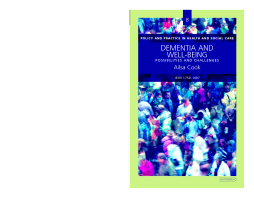
Additional Information
Book Details
Abstract
Critically assesses recent health and social care policy in Scotland and England in light of the growing body of empirical research into the experiences and perspectives of people with dementia. The author draws on this evidence to consider the particular challenges associated with delivering four key outcomes to people with dementia identified by policy makers as fundamental to well-being. These are: independence, health, choice and social inclusion. The book examines the potential for current policy proposals to meet the needs of people with diverse experiences of dementia and considers the particular issues relating to including people with dementia as partners in policy and practice - a key principle underpinning all health and social care. In so doing the book contributes a much needed policy perspective to the field of dementia, as well as providing a fresh lens through which to consider the difference that proposed policies can make to a diverse range of service users.
Table of Contents
| Section Title | Page | Action | Price |
|---|---|---|---|
| Acknowledgements | |||
| Preface | |||
| Executive Summary | |||
| Abbreviations | |||
| Main report | |||
| Introduction | |||
| Methodology | |||
| Cereal fortification and blended food | |||
| Food and nutrition in the study sites | |||
| The 'pragmatics of preference' | |||
| The use of food and micronutrients | |||
| What made food 'acceptable'? | |||
| Cereal fortification at the regional, camp, and household levels | |||
| Conclusions | |||
| Appendices: | |||
| Methods | |||
| Fortified pre-cooked blended food: definitions and examples | |||
| Prices, nutritional values, and unit cost of WFP-supplied commodities, January 1997 | |||
| Composition and nutritional analysis of planned rations | |||
| Case-study: Bhutanese refugees in Nepal (January/February 1997) | |||
| The context | |||
| The field study | |||
| Conclusion | |||
| Appendices: | |||
| Map of Jhapa and Morang Districts | |||
| Age and gender composition of camp population | |||
| Market prices at time of study | |||
| The proces of parboiling rice | |||
| List of key informants and interviewees | |||
| Case-study: Somali refugees in Ethiopia | |||
| The context | |||
| The field study | |||
| Conclusion | |||
| Appendices: | |||
| Ethiopia: regions and zones | |||
| Location of camps, Somali Region | |||
| Characteristics of teh refugee population | |||
| Refugee numbers | |||
| Market prices at time of study | |||
| Chronology of malnutrition and micronutrient deficiencies | |||
| List of key informants and interviewees | |||
| Case-study: Burundian refugees in Tanzania | |||
| The context | |||
| The field study | |||
| Conclusion | |||
| Appendices: | |||
| Map: Kigoma Region and location of camps | |||
| Age and sex composition of population, Muyovosi camp | |||
| Refugees Statistics Report on Registration, Kigoma Region, July 1997 | |||
| Summary of food ration scales and kilo calories, January-August 1997 | |||
| Proposed milling set-up, Isaka | |||
| List of key informants and interviewees | |||
| Glossary | |||
| References |
